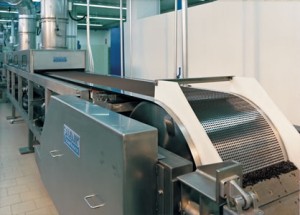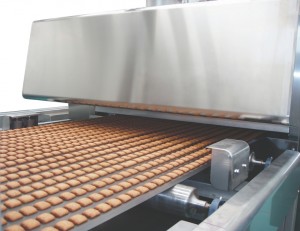Hygienic Processing on Stainless Steel Conveyors

This year marks the 100th anniversary of the first commercial casting of stainless steel, a material that has had a greater impact on the food and drink business than perhaps any other.
While the original goal of metallurgist Harry Brearley was extra durability, extending the life of British gun barrels, its other qualities – notably resistance to corrosion and ease of cleaning – have made it the default solution for virtually any hygiene-critical application. And as far as conveying is concerned, Sandvik Process Systems has led the way since producing the first stainless steel belt in 1931.
Today, Sandvik’s steel belts are used across a whole range of food applications, from simple conveying to the processing of fish, meat, poultry, fruit, vegetables, coffee, tea, confectionery, baked goods, pet foods and more.
For some of these applications, the thermal properties are key. No other material can be used across range of processes that includes freezing, cooling, steaming, solidifying, drying and baking, and in just about every case the ability of the steel belt to conduct heat quickly and efficiently is a major benefit. Plus of course, few if any other materials could tolerate such a wide range of conditions, from extreme humidity to intense heat or sub-zero temperatures.
For others, it is the inherent durability of stainless steel that makes Sandvik’s belts the right investment decision. Far more resistant to damage by corrosion, abrasion or impact than any other belt type, a stainless steel conveyor provides the ideal long term solution for potentially aggressive applications such as sugar conveying or meat boning plants.
In every case though, it is the ease of cleaning and consequent high standards of hygiene that really set stainless steel belts apart from other materials.
Superior Cleanability
This superior cleanability was highlighted in research findings published by Finnish food laboratory VTT Expert Services Ltd., confirming that risk of problems caused by bacterial build-up can be reduced, simply by upgrading to a stainless steel conveyor.
The research looked at the ‘cleanability’ of three basic conveyor types used in meat processing – stainless steel, solid plastic and plastic slats – and concluded that: “stainless steel is more cleanable than the two different plastic surfaces tested according to the culturing results. The difference is more significant for damaged surfaces.”
So why is stainless steel more cleanable than other materials? Primarily, it is its flat and solid form: there are no gaps or textures in which bacteria can hide. Steel belts are installed in what is called ‘endless’ form, meaning the two ends are welded together to form the conveyor loop, then ground to remove any trace of the joint.
In addition they can be sanitised in whatever way is most appropriate to the operation: hot water, pressure, brushes, detergents, chemicals or any combination of these.
World’s Largest Supplier
As the world’s largest supplier of stainless steel belts to the food industry, Sandvik has the engineering know how and flexibility to meet every customer’s needs.
 With regional manufacturing centers and a worldwide network of service and installation engineers, Sandvik can supply complete conveying lines. These systems can incorporate food hygiene features such as all-stainless steel framework, easy-to-clean design, food-approved bearings, and IP65 motors.
With regional manufacturing centers and a worldwide network of service and installation engineers, Sandvik can supply complete conveying lines. These systems can incorporate food hygiene features such as all-stainless steel framework, easy-to-clean design, food-approved bearings, and IP65 motors.
The company’s engineers can work to support OEMs, designing and installing steel belts and associated components (eg skid bars and compact belt tracking controls) onto their conveyor systems.
This expertise is available in the form of consultancy, helping manufacturers and processors upgrade conveyors from existing belt materials to solid or perforated steel belts.
Sandvik’s long relationship with the food industry extends to the design, manufacture and commissioning of end-to-end process systems. One area in which the company has particular expertise is cooling and Sandvik’s systems are widely used for the controlled solidification of products such as chocolate, sugar mass, confectionery, emulsifiers and fats.
In this as in other areas, Sandvik’s use of stainless steel belts has proven to be an extremely reliable solution, one that combines operational efficiency and exceptional standards of hygiene to ensure production of a high quality end product, and all for an attractive return on investment.



































